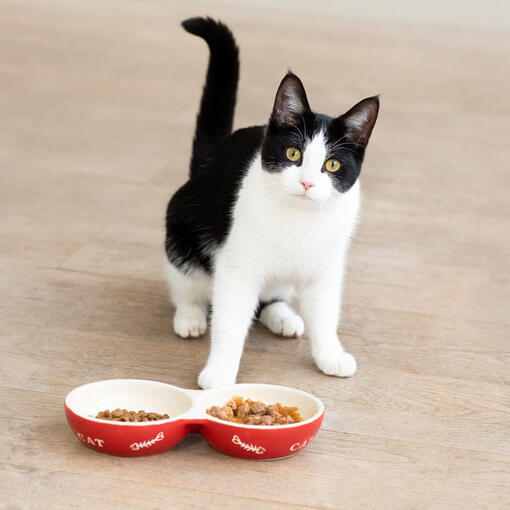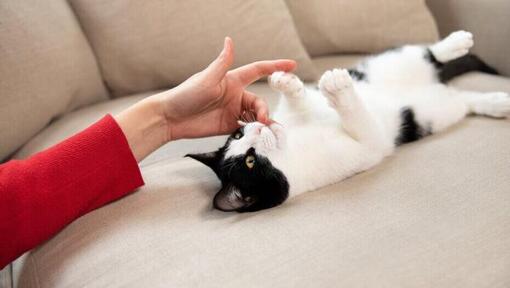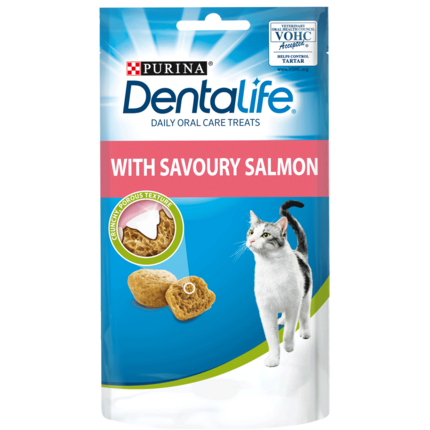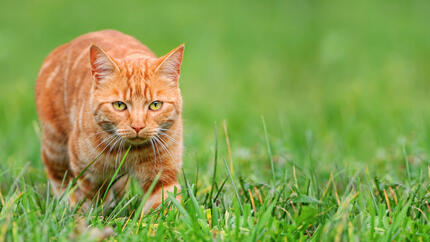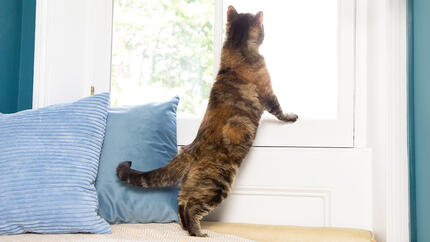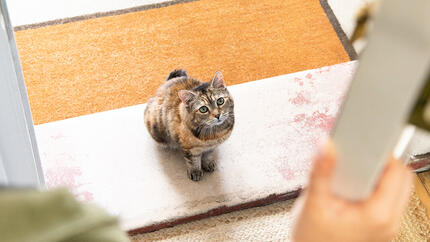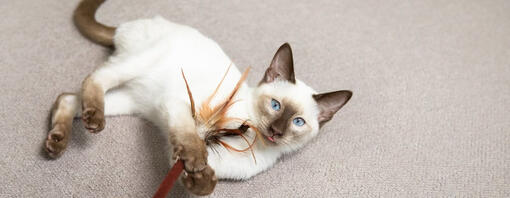
Cats, especially kittens, are playful by nature. As they start to grow up, this play enables them to develop their natural hunting skills, teaches them dexterity and coordination, enhances physical development, and gives them an outlet for all those crazy bursts of kitten energy.
Most importantly, kitten play is a great bonding opportunity for you and your cat, along with being fun for you and one of the joys of sharing your life with a cat!
We’ve put together this useful guide packed full of useful information to tell you everything you need to know, from selecting the best kitten toys to the reasons behind why cats like to play. Keep reading to find out more.
Why do cats like to play?
What appears as ‘play’ is your cat learning vital survival skills such as how to stalk, chase and trap prey. As well as practising and honing their hunting and pouncing skills, this helps them develop their dexterity and coordination, keeps them fit and healthy, and gives them an outlet for all their natural behaviours while burning off some energy. All of this combines to help keep your cat physically and mentally healthy and happy.
Kittens will start showing play behaviours almost as soon as they are sentient and mobile. From as early as four weeks old they’ll spend most of their waking time wrestling with their brothers, sisters and mum. From the age of seven to eight weeks old, they’ll start to turn their attention to predatory play with toys – especially those that move.
Benefits of playing with your cat
Play isn’t just a fun part of living with your cat, it’s an essential feature to help them stay emotionally and physically healthy. A few of the main benefits of kitten play include:
Giving them an outlet for their natural predatory behaviours
Cat play is all based around their predatory behaviours – stalking, chasing, pouncing, grabbing and ‘killing’. Cats need to have an outlet for these behaviours in order to stay content and happy. It’s up to you to provide this enrichment in the form of toys and play. The best kitten toys to encourage this type of play are fishing rod type toys and small, soft toys which can be rolled past them to attract their attention and encourage them to pounce and chase. There are also toys that move around on their own (battery or rechargeable) or food dispensing toys that need some feline dexterity to give up their treats.
Mental and physical stimulation
Playing for at least 20 minutes a day provides both mental stimulation and important exercise for your cat, plus you’ll be having fun together and strengthening the bond between you. Play is especially essential for indoor cats who do not get the natural enrichment of being outside and who would otherwise have no outlet for their natural behaviour.
Indoor cats need Make sure they have play opportunities such as cat trees that let them climb, scratch and supervise their territory from on high – as they would while out supervising their territory.
Your kitten or cat’s peak play times are usually in the early morning and the evening so these are the ideal times to play with them to help prevent the zoomies and to ensure that your kitten’s just as relaxed and content as you are by bedtime.
Playing as a form of cat exercise
We all know that dogs burn off a lot of energy chasing balls, playing dog sports and being taken on walks, but for cats, things will be very different. Naturally cats will spend a lot of energy hunting for their food – and the rest of the time conserving their energy until they decide they need to get out and stalk themselves their next meal. – So unless you provide them with play opportunities that will take the place of their hunting expeditions, they can easily lead a sedentary life with little more than stretching out on the sofa to snoozing in the sun! And just like us, this isn’t good for them physically – or mentally.
So how can you make sure your cat is getting enough exercise?
The answer is simple: have fun playing with them! From kittenhood right through to old age, they’ll love batting, chasing and pouncing all kinds of things! In fact, playing with your cat and having fun together is one of the most enjoyable things about sharing your life with your feline friend.
Hide and seek cat games
Your cat has a lot of natural intelligence that needs to be exercised in order to keep them satisfied, and one way to do this is giving them the opportunity to forage and search for some of their food.
In the wild, most of your cat’s energy would be spent finding food – and so we can use this instinct to prove more enrichment for our own cat. This can prevent boredom, make your cat’s life more interesting, and give them something to do that isn’t scratching your furniture, pouncing on your feet, or beating up the dog!
Bored pets may also sleep a lot which makes them more lethargic, which in turn makes them want to exercise even less, leading to more weight gain. Rather than enter that vicious circle, a good hide and seek food game will combine eating with exercise, just as your cat would do in the wild.
These hide and seek games should be easy to do – but still provide some enrichment. Using empty toilet roll or kitchen roll tubes can be perfect. You start by putting some dried food in there and leaving it beside (or even in) your cat’s food bowl. Once they work out how to get the food out, you can fold the ends over so they have to rip or claw at it, as they would with ‘real’ prey. You can then start to put these in other places around the house for your cat to ‘hunt out’.
Deliver boxes can work in exactly the same way – and let’s face it… most cats love a box anyway!
5 of the best kitten toys
There’s a huge variety of kitten toys out there so you’re sure to find something your feline will love playing with. Here’s some of the best kitten toys you can get to engage their senses:
1. Fishing poles and teasers
Fishing poles and teasers are a classic kitten toy and a firm favourite with cats. You’ll usually find them with things like toys attached to the end and they’re a great way for you to play with your cat as you can wiggle the line which is very enticing for them! Fishing poles are some of the best kitten toys as they help to develop skills such as stalking, chasing and pouncing.
2. Mice toys
Cats and kittens often enjoy toys which look like prey – and even more is filled with cat nip! You may spot your kitten pouncing on them around the house and they may even be so kind as to bring you their spoils after. There are tonnes of kitten toys like this including teddy bear mice and even crinkly ones too. Adult cats rarely play with toys that don’t move however – so you will probably have to get involved in this (possibly one-sided) game of fetch too.
3. Interactive toys
Interactive toys are fantastic for engaging your kitten’s brain. There’s lots of great options out there including motion activated fish and mice, puzzles and feather chasers and some even incorporate treats to encourage play for those that need a little convincing. Lots of cats enjoy lickimats too – and this can be a great way to feed your cat wet food.
4. Scratchers
Scratchers are essential, even for kittens! These toys help to shed the outer layers of their claws and allow them to mark their territory. On top of helping them to express their natural instincts, they’ll also save your soft furnishings and carpets as it’ll give them somewhere especially for this purpose. Scratchers come in all shapes and sizes including towers, trees and ramps, and come in a variety of materials. Spend some time discovering what your kitten or cat prefers – and then supply several of these. It’s good to have a few in a variety of different heights – and most cat trees have a scratching post build to in too!
5. Tunnels
Tunnels can make great toys as many cats just love to explore dark spaces and they’re a great way to engage their senses. You can get a variety of different types including simple one-way tunnels and ones that link up to create a little maze. Others can be soft and furry – which can be fun to play in – or snooze in!
Homemade kitten toys
Sometimes kitten toys can be expensive – but it doesn’t have to be that way! You can make excellent toys out of things that you may find lying around the house. Why not try one of the following:
- A bucket filled with crumpled paper or ping-pong balls can make a useful distraction. When your kitten attempts to stalk you, throw a ball downstairs for them.
- Leave a large paper bag on the floor for diving into and ripping to pieces, but don’t use plastic bags and cut off any handles that could get caught around your cat's neck.
- Cardboard boxes to jump in and out of are also fun. Glue several boxes together, linked by peepholes, for kitten hide-and-seek, and put a ball or mouse toy inside for extra excitement.
- Make a sack of fabric stuffed with dried catnip, which drives some cats wild!
Potentially harmful toys to avoid
There are a number of cat toys which are unsafe for your feline to play with, these include:
- Balls of wool or string.
- Rubber bands.
- Plastic bags.
- Paper clips.
- Dental floss.
- Feathers.
- Toys with small parts.
- Toys that are small enough for your cat to swallow.
- Make sure you cat proof your house and don’t leave anything that could harm your cat lying around, remember that kittens especially are very curious creatures and may try to play with things they shouldn’t!
Why are some cats more active than others?
Some cat breeds have a reputation for snoozing a lot of the time, while others are generally known for their active attitudes. Pure breeds with reputations for high activity include Bengals, Siamese, Abyssinian, and Oriental, while more laid-back cats include the Persian, Himalayan, British Shorthair and Ragdoll breeds. But every cat is an individual and there are many active and fun kittens in rescue centres and shelters just waiting for homes and a new play partner!
Cats are just like us when it comes to exercise - some are simply more active than others. However, it’s not normal for your cat to sleep all the time and to be totally uninterested in interacting with you – especially if this is a new behaviour. Consult your vet if your cat is very inactive as this may indicate a medical problem.
Redirecting playful aggression
If your kitten is keen on attacking your ankles, try to redirect this behaviour onto their kitten toys instead. Look at how much enrichment opportunities you are giving them – and how much of a chance to practise their natural predatory behaviours. If you don’t give them this outlet, you can’t blame them for going ‘self employed’.
Cats tend to be solitary animals, but two siblings will often get on well and can keep each other occupied. But you could just as easily end up with two predators instead of one – or bitter enemies! If after adding plenty of enrichment into your cat’s life, they are still behaving aggressively, contact a feline behaviourist for advice on dealing with this inappropriate predatory behaviour.
Keep your cat healthy through play
Overweight kittens can easily become overweight cats, and fat cats aren't healthy cats! Overweight cats are more likely to suffer from painful osteoarthritis and conditions such as diabetes and urinary problems. Keeping your cat at an ideal body weight is important. Kitten play and exercise will help control your cat's weight and prevention is always better than a cure. You can check your cat's weight yourself with our body condition score tool. Any doubts always ask your vet and if you think they may be overweight they can help you with solutions to reduce your cat's weight. To keep up activity levels, invest in some cat exercise toys, an indoor climbing frame or a scratching post. Introduce regular play sessions and remember that anything that moves will appeal to cats, as it gives them a chance to polish their hunting skills.
Want more kitten content? Read our guide on making your home cat friendly and get ready for your new arrival.


